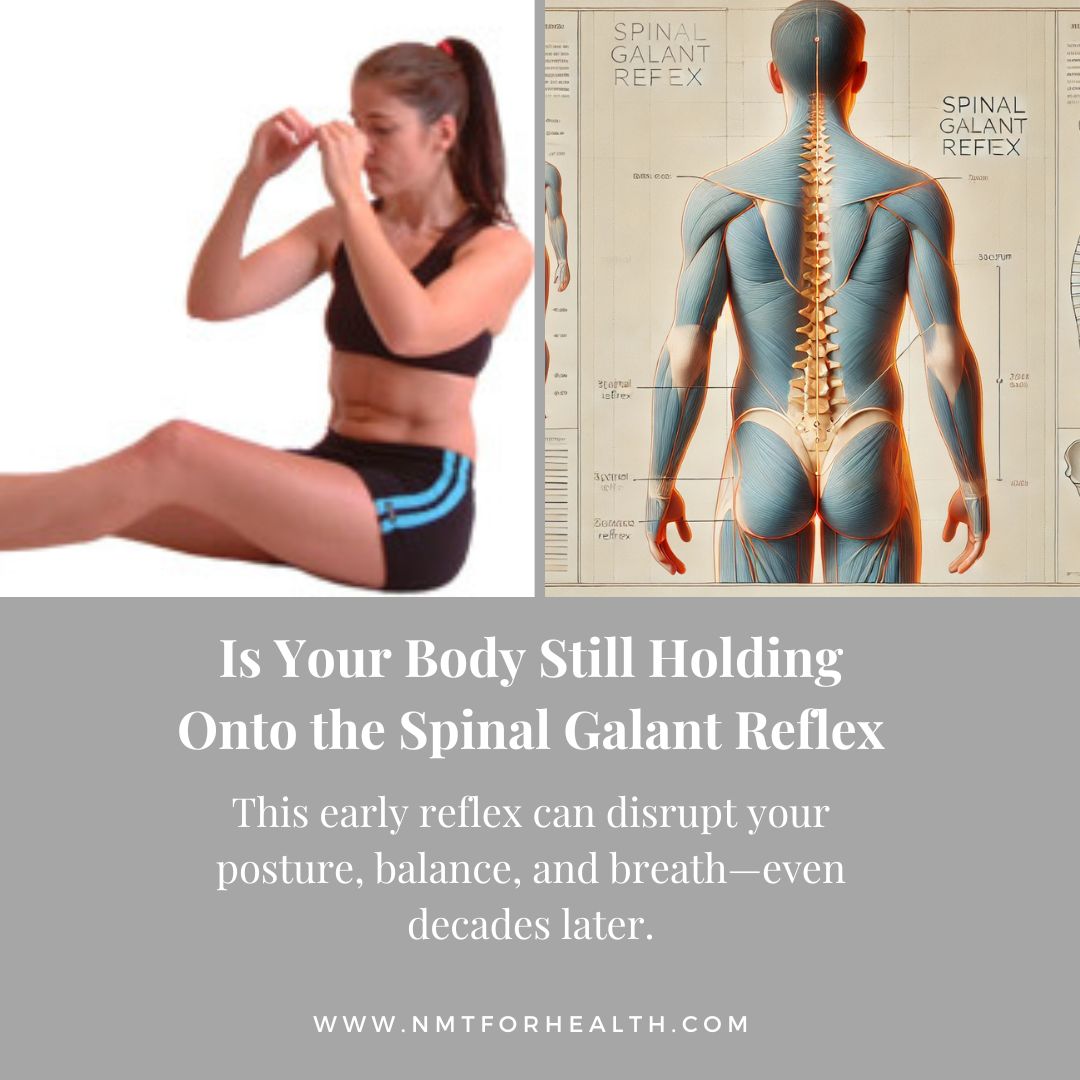How a primitive reflex might be quietly shaping your posture, breathing, and chronic tension
Have you ever felt like your body just won’t let go of tension—no matter how much you stretch, strengthen, or breathe? Maybe your hips feel tight, your jaw clenches when you’re trying to relax, or your balance still feels off even though you’ve done the work.
What if part of the problem isn’t weakness—but a pattern your body learned decades ago?
Some early primitive reflexes—like the Spinal Galant reflex—are meant to fade as we grow. But when that process is incomplete or disrupted, they can stick around in subtle ways and affect posture, breathing, stability, and even chronic pain.
If you’ve ever felt like no amount of stretching, breathwork, or core strengthening helps your chronic pain or tension, this could be part of the puzzle. And if your upper body feels like it’s doing all the work—clenching your jaw, gripping your toes, or bracing your shoulders—while your hips feel disconnected or tight, it’s worth exploring how primitive reflexes and compensation may be at play.
What Is a Primitive Reflex?
A primitive reflex is an automatic movement pattern we’re born with. These early reflexes help babies move, stabilize, and begin wiring their nervous system for posture, balance, and control.
The Spinal Galant reflex, for example, helps stimulate hip motion and prepares the spine for crawling. This primitive reflex typically integrates around 9 to 12 months of age. When it doesn’t integrate fully, it can linger and influence posture and movement in adulthood.
Signs of a Retained Primitive Reflex in Adults
In adults, a retained primitive reflex often shows up as compensation patterns. Instead of stabilizing with the deep core, the body may default to clenching the glutes, bracing the abs, or tightening the jaw. These habits create tension where there should be support—and can contribute to recurring or unexplained chronic pain.
It also affects the autonomic nervous system, making it harder to switch between stress and calm states.
Clients who wore leg braces as children, had frequent ankle sprains, or struggled with early coordination delays may carry movement patterns shaped by primitive reflexes.
You may also notice:
- Chronic knee hyperextension or instability
- A rigid, arched low back
- Tension that doesn’t resolve with strength or flexibility work
These are signs that the nervous system may still be relying on outdated primitive reflex patterns for stability.
Nervous System Reset: Breath, Vagus Nerve & Organ Motility
When primitive reflex patterns remain active, they can disrupt the natural rhythm of the breath and the nervous system.
Shallow breathing, diaphragm tension, and reduced vagal tone are common. These affect the body’s ability to digest, recover, and regulate inflammation. Supporting breath and restoring organ motility is a gentle but powerful way to help the nervous system let go of compensation.
Client Story: Letting Go of Compensation Patterns for Good
One client came to me with TMJ pain, chronic neck tension, and a lingering sense of instability. She had worked with a physical therapist and a pelvic floor specialist and tried several self-care approaches, but the same tension patterns kept resurfacing.
When we began syncing her breath with her core and pelvic floor, her pelvis found a more neutral position. Her core could activate without bracing, and her balance noticeably improved. Releasing tension in her jaw and neck muscles, like the SCM, helped improve her sense of stability and body awareness.
We also discovered a small scar on her lower back—from a procedure years ago. While fully healed on the surface, it was positioned in a way that may have been interfering with fascia glide and proprioceptive signaling—mimicking how the body might respond when old movement patterns are still running in the background.
Over time, she built a consistent self-care routine that reconnected her breath, posture, and movement patterns. Instead of managing symptoms, she began to feel more stable, supported, and in tune with her body.
A Simple At-Home Reset for Primitive Reflex Patterns
-
Place a soft Pilates ball between your thighs and gently hug it as you inhale and exhale slowly
-
Let your inner thighs and deep core engage naturally—no bracing
-
Try balancing barefoot on one leg, even for a few seconds
-
Pay attention: are you gripping your toes, clenching your jaw, or holding your breath?
These small moments of awareness can reveal how your body might still be relying on outdated reflex patterns for stability. The goal isn’t to push—it’s to help your body feel supported enough to move with ease.
Want more guidance? These are the foundational principles in my book, Your Body’s Natural Stack™: Rediscover Balance Through Breath and Alignment
👉 Read it on Kindle
The Bigger Picture: Letting Go of Primitive Reflex Compensation
The Spinal Galant and other primitive reflexes don’t always fade on their own. But the good news is, they can be re-patterned with the right approach.
If you’re dealing with chronic pain, shallow breathing, or postural tension that won’t go away, your nervous system might be relying on a pattern it learned decades ago.
Let’s explore what your body is still holding onto—and how to help it let go.
Click here to book a Discovery Session
A Note on the Science
The concept of a retained primitive reflex is well-established in developmental neuroscience, occupational therapy, and neurorehabilitation. Research has shown that when these reflexes don’t fully integrate, they can influence posture, coordination, and nervous system regulation well into adulthood. They’re most often studied in children with ADHD or sensory issues but are increasingly recognized as relevant in adults who experience chronic compensation patterns.
While direct research on primitive reflexes in aging adults is limited, related studies show that:
-
Hormonal changes—such as during perimenopause or postpartum—can affect neuromuscular control and postural stability (Leblanc et al., 2017; Tenan et al., 2013)
-
Aging is associated with decreased proprioception and slower reflex response, impacting coordination and movement efficiency (Goble et al., 2009; Lord et al., 2003)
-
Chronic stress and trauma can increase protective muscle tone and mimic early movement patterns (Levine, Porges)
Together, these findings help explain why some people may develop or re-engage compensatory patterns that resemble retained primitive reflexes—particularly when the body is under stress, recovering from injury, or navigating hormonal shifts.
Why This Is Often Overlooked in Traditional Care
Most doctors and physical therapists aren’t trained to assess primitive reflexes in adults. These patterns are typically addressed only in pediatric or specialized neurological care—so they’re rarely considered in cases of chronic tension or postural issues.
In my work, I help bridge that gap by observing reflex-like compensation patterns and supporting the nervous system through breath, alignment, and hands-on techniques that gently encourage more functional, efficient movement.
Important Note
Retained primitive reflexes are just one potential piece of the puzzle. Chronic low back pain, hip tightness, or postural imbalance may also stem from repetitive strain, past injuries, emotional stress, or underdeveloped movement habits.
What makes reflex-driven patterns unique is that they can silently shape how the body organizes itself—often long after the original trigger is gone. Supporting the nervous system through breath, balance, and whole-body awareness helps bring these patterns into a more functional state.
My goal is always to assess the whole-body story—not just treat a symptom.
References
-
Konicarova, J., & Bob, P. (2013). Persistence of primitive reflexes and ADHD symptoms in children. Neuropsychiatric Disease and Treatment
-
Stecco, C., et al. (2014). Fascial components of the myofascial pain syndrome. Current Pain and Headache Reports
-
Goddard, S. (2005). Reflexes, Learning and Behavior: A Window into the Child’s Mind
-
Leblanc, A. D., et al. (2017). Menopause and neuromuscular changes: implications for postural control
-
Tenan, M. S., et al. (2013). Influence of hormonal fluctuations on neuromuscular control
-
Goble, D. J., et al. (2009). Proprioceptive decline with age
-
Lord, S. R., et al. (2003). Postural stability and aging
FAQ: Could Old Movement Patterns Still Be Affecting Me?
Q: How do I know if early reflex patterns might still be influencing my posture or tension?
A: There’s no formal test for adults, but I often observe patterns that suggest the nervous system is still relying on outdated strategies for stability—especially in people with chronic tension, low back pain, or postural compensation that hasn’t resolved with stretching or strengthening alone.
These patterns may show up as:
-
Breath-holding during movement or balance
-
Tightness in the low back or hips that doesn’t respond to release work
-
Difficulty standing on one leg without clenching the feet or jaw
-
Sensitivity along the spine when touched
-
Jaw or neck tension showing up when trying to stabilize or move
These are not signs of weakness—they’re often signs your body is still trying to protect and stabilize in the only way it knows how. The good news is, through breath, core coordination, and nervous system-informed movement, we can gently help your body shift into a more balanced, supported state.
About the Author
Mara Nicandro, LMT, NMT, is a Board-Certified Neuromuscular Therapist with over 20 years of experience helping clients uncover the root of chronic pain through breathwork, alignment, and nervous system reeducation. Her holistic approach bridges the gap between physical therapy and body-based self-care to support lasting change.

